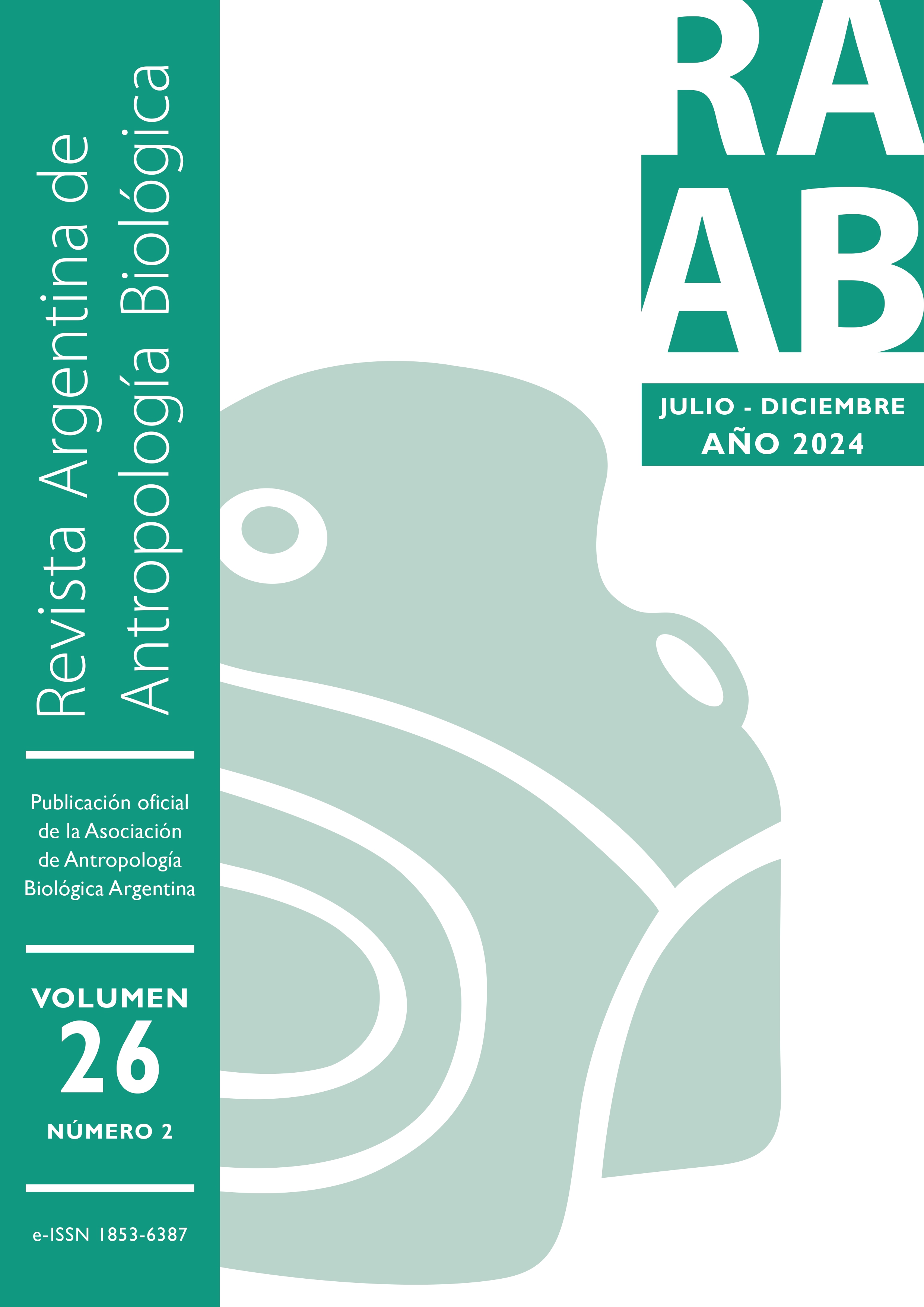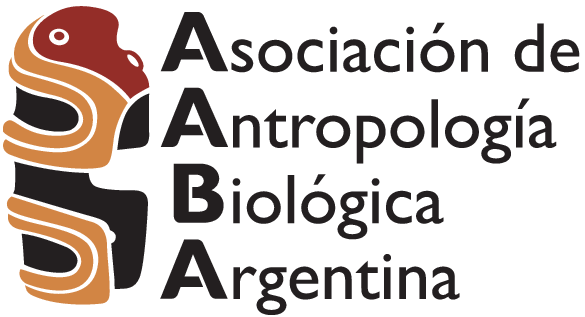El desgaste oclusal en humanos: la perspectiva antropológica
DOI:
https://doi.org/10.24215/18536387e080Palabras clave:
desgaste dental, bioarqueología, dieta, plano helicoidal, uso masticatorio y extramasticatorioResumen
El desgaste oclusal ha sido parte del camino evolutivo del ser humano desde que apareció el género Homo. Desde una perspectiva antropológica, y pese a las limitaciones objetivas que conlleva el estudio del desgaste dental, su análisis es de suma importancia para la estimación de la edad de muerte, para hacer inferencias sobre la dieta, sobre el modo en que los alimentos eran preparados y procesados, y sobre el uso cultural de los dientes como tercera mano en actividades extramasticatorias. Su estudio, además, permite reconstruir el modo en que el desgaste ha ido evolucionando debido a los cambios evolutivos que han caracterizado al ser humano desde la revolución Neolítica y la introducción de la agricultura, hasta la Revolución Industrial en tiempos más recientes. Esta breve reseña se centra en el estudio del desgaste oclusal desde la perspectiva antropológica y bioarqueológica. Discute su importancia y relevancia para reconstruir y entender las sociedades del pasado, sus ventajas y limitaciones en el estudio de restos esqueléticos humanos, y cómo diferentes campos de estudio, de la odontología a la antropología dental/bioarqueología, se enfocan en su estudio desde perspectivas diferentes que no siempre se sobreponen, pero que pueden beneficiarse entre sí de un acercamiento multidisciplinario.
Descargas
Referencias
Azouzi, I., Kalghoum, I., Hadyaoui, D., Harzallah, B., & Cherif M. (2018). Principles and guidelines for managing tooth wear: A review. Internal Medicine and Care, 28, 1-9. https://doi.org/10.15761/IMC.1000112
Benazzi, S., Kullmer, O., Gross, I. R., & Weber. G. W. (2011). Using occlusal wear information and finite element analysis to investigate stress distributions in human molars. Journal of Anatomy, 219(3), 259–272. https://doi.org/10.1111/j.1469-7580.2011.01396.x
Benazzi, S., Nguyen, H. N., Kullmer, O., & Kupczik, K. (2016). Dynamic modelling of tooth deformation using occlusal kinematics and finite element analysis. Plos ONE, 11(3), e0152663. https://doi.org//10.1371/journal.pone.0152663
Brothwell, D. R. (1963). Digging up bones. The excavation, treatment and study of human skeletal remains. British Museum of Natural History.
Brown, T., Townsend, G. C., Pinkerton, S. K., & Rogers, J. R. (2011). Yuendumu. Legacy of a longitudinal growth study in Central Australia. The University of Adelaide Press.
Buikstra, J. E. (1997). Studying Maya bioarchaeology. In S. L. Whittington & D. M. Reed (Eds.), Bones of the Maya: Studies of ancient skeletons (pp. 221-228). Smithsonian Institution.
Buzon, M. R., & Bombak, A. (2010). Dental disease in the Nile Valley during the New Kingdom. International Journal of Osteoarchaeology, 20(4), 371-387. https://doi.org/10.1002/oa.1054
Campbell, T. D. (1956). Comparative human odontology. Australian Dentistry Journal, 1, 26-32.
Chatters, J. C. (2014). Geography, paleoecology, and archaeology. In D. W. Owsley & R. L. Lantz (Eds.), Kennewick Man. The scientific investigation of an ancient American skeleton (pp. 30-58). Texas A&M University Press.
Cohen, M. N., & Armelagos, G. J. (Eds.). (1984). Paleopathology at the origins of agriculture. Academic Press.
Cucina, A., Herrera-Atoche, R., & Chatters, J. C. (2019). Oral health and diet of a young Late Pleistocene woman from Quintana Roo, Mexico. American Journal of Physical Anthropology, 170, 246-259. https://doi.org/10.1002/ajpa.23884
Cucina, A., Vega Lizama, E. M., & Chatters, J. C. (2021). Dental morphology of Late Pleistocene Naia and the sinodont/sundadont issue. PaleoAmerica, 7(2), 145-161. https://doi.org/10.1080/20555563.2021.1895531
Dahlberg, A. A. (1963). Analysis of the American Indian dentition. In D. R. Brothwell (Ed.), Dental anthropology (pp. 149-178). Pergamon Press.
Deter, C. A. (2009). Gradients of occlusal wear in hunter-gatherers and agriculturalists. American Journal of Physical Anthropology, 138, 247-254. https://doi.org/10.1002/ajpa.20922
Edgar, H. J. H. (1997). Paleopathology of the Wizards Beach Man (AHUR 2023) and the Spirit Cave mummy (AHUR 2064). Nevada Historical Society Quarterly, 40, 57-61.
Eshed, V., Gopher, A., & Hershkovitz, I. (2016). Tooth wear and dental pathology at the advent of agriculture: New evidence from the Levant. American Journal of Physical Anthropology, 130, 145-159. https://doi.org/10.1002/ajpa.20362
Gilmore, C. C., & Grote, M. N. (2012). Estimating age from adult occlusal wear: A modification of the Miles method. American Journal of Physical Anthropology, 149, 181-192. https://doi.org/10.1002/ajpa.22106
Gkantidis, N., Dritsas, K., Ren, Y., Halazonetis, D., & Katsaros, C. (2020). An accurate and efficient method for occlusal tooth wear assessment using 3D digital dental models. Scientific Reports, 10, 10103. https://doi.org/10.1038/s41598-020-66534-4
Green, T. J., Cochran, B., Fenton, T. D., Woods, J. C., Titmus, G. L., Tieszen, L., Davis, M. A., & Miller, S. J. (1998). The Buhl burial: A Paleoindian woman from Southern Idaho. American Antiquity, 63, 437-456. https://doi.org/10.2307/2694629
Greene, D. L., Ewing, G. H., & Armelagos, G. J. (1967). Dentition of a Mesolithic population from Wadi Halfa, Sudan. American Journal of Physical Anthropology, 27, 41-56. https://doi.org/10.1002/ajpa.1330270107
Hall, R. L. (1976). Functional relationships between dental attrition and the helicoidal plane. American Journal of Physical Anthropology, 45, 69-76. https://doi.org/10.1002/ajpa.1330450109
Herrera-Atoche, R., Chatters, J. C., & Cucina, A. (2022). Unexpected malocclusion in a 13,000-yearold Late Pleistocene young woman from Mexico. Scientific Reports, 12, 3997. https://doi.org/10.1038/s41598-022-07941-7
Hillson, S. (2002). Dental anthropology. (3rd ed.). Cambridge University Press.
Hillson, S. (2014). Tooth development in human evolution and bioarchaeology. Cambridge University Press.
Hosek, L., & Robb, J. (2019). Osteobiography: A platform for bioarchaeological research. Bioarchaeology International, 3, 1-15. https://doi.org/10.5744/bi.2019.1005
Hubbe, M., Torres-Rouff, C., Neves, W. A., King, L. M., Da-Gloria, P., & Costa, M. A. (2012). Dental health in Northern Chile’s Atacama oases: Evaluating the Middle Horizon (AD 500-1000) impact on local diet. American Journal of Physical Anthropology, 148, 62-72. https://doi.org/10.1002/ajpa.22042
Irish, J. D., & Turner II, C. G. (1987). More lingual surface attrition of the maxillary anterior teeth in American Indians: Prehistoric Panamanians. American Journal of Physical Anthropology, 73, 209-213. https://doi.org/10.1002/ajpa.1330730207
Jantz, R. L., & Owsley, D. W. (1997). Pathology, taphonomy, and cranial morphometrics of the Spirit Cave mummy. Nevada Historical Society Quarterly, 40, 62-84.
Johansson, A. (1992). A cross-cultural study of occlusal tooth wear. Swedish Dental Journal, 86, 1-59.
Lagan, E. M., & Ehrlich, D. E. (2021). An improved method for measuring molar wear. American Journal of Physical Anthropology, 174, 832-838. https://doi.org/10.1002/ajpa.24238
Larsen, C. S. (2015). Bioarchaeology. Interpreting behavior from the human skeleton. (2nd ed.). Cambridge University Press.
Lozano, M., Bermudez de Castro, J., Carbonell, E., & Arsuaga, J. K. L. (2008). Non-masticatory uses of anterior teeth of Sima de los Huesos individuals (Sierra de Atapuerca, Spain). Journal of Human Evolution, 55, 713-728. https://doi.org/10.1016/j.jhevol.2008.04.007
Lovejoy, C. O. (1985). Dental wear in the Libben population: Its functional pattern and role in the determination of adult age at death. American Journal of Physical Anthropology, 68, 47-56. https://doi.org/10.1002/ajpa.1330680105
Mays, S. (2002). The relationship between molar wear and age in an early 19th century AD archaeological human skeletal series of documented age at death. Journal of Archaeological Science, 29, 861-871. https://doi.org/10.1006/jasc.2001.0751
Mays, S. (2015). The effect of factors other than age upon skeletal age indicators in the adult. Annals of Human Biology, 42(4), 330-339. https://doi.org/10.3109/03014460.2015.1044470
Mays, S., de la Rua, C., & Molleson, T. (1995). Molar crown height as a means of evaluating existing dental wear scales for estimating age at death in human skeletal remains. Journal of Archaeological Science, 22, 659-670. https://doi.org/10.1016/S0305-4403(95)80151-0
Mays, S., Zakrzewski, S., & Field, S. (2022). The relationship between dental wear and age at death in British archaeological human skeletal remains: A re-evaluation of the ‘Brothwell Chart’. Journal of Archaeological Science: Reports, 46, 103707. https://doi.org/10.1016/j.jasrep.2022.103707
Molnar, S. (1971). Human tooth wear, tooth function and cultural variability. American Journal of Physical Anthropology, 34, 175-190. https://doi.org/10.1002/ajpa.1330340204
Molnar, P. (2011). Extramasticatory dental wear reflecting habitual behavior and health in past populations. Clinical Oral Investigation, 15, 681-689. https://doi.org/10.1007/s00784-010-0447-1
Moorrees, C. (1957). The Aleut dentition. A correlative study of dental characteristics in an Eskimoid people. Harvard University Press.
Murphy, T. (1959). The changing pattern of dentine exposure in human tooth attrition. American Journal of Physical Anthropology, 17, 167-178. https://doi.org/10.1002/ajpa.1330170302
Neves, D., Silva, A. M., Simöes, F., & Wasterlain, S. N. (2022). More than they could chew: Activity-induced dental modifications in a Portuguese medieval-modern rural population. International Journal of Osteoarchaeology, 32, 856-865. https://doi.org/10.1002/oa.3113
Oliveira, R. N., Silva, S. F., Kawano, A., & Antunes, J. L. F. (2006). Estimating age by tooth wear of prehistoric human remains in Brazilian archaeological sites. International Journal of Osteoarchaeology, 16, 407-414. https://doi.org/10.1002/oa.840
Osborn, J. W. (1982). Helicoidal plane of dental occlusion. American Journal of Physical Anthropology, 57, 273-281. https://doi.org/10.1002/ajpa.1330570305
Owsley, D. W., Williams, A. A., & Bruwelheide, K. S. (2014). Skeletal inventory, morphology, and pathology. In D. W. Owsley & R. L. Lantz (Eds.), Kennewick Man. The scientific investigation of an ancient American skeleton (pp. 139-186). Texas A&M University Press.
Pedersen, P. O. (1949). The East Greenland Eskimo dentition, numerical variations and anatomy. Meddelelser om Grönland, 142(3), Biance Lunos Bogtrykken.
Robb, N. D., Cruwys, E., & Smith, B. G. N. (1991). Is “lingual surface attrition of the maxillary teeth (LSAMAT)” caused by erosion? American Journal of Physical Anthropology, 85, 345-351. https://doi.org/10.1002/ajpa.1330850315
Saul, F. P. (1972). The human skeletal remains of Altar de Sacrificios: An osteobiographic analysis. Papers of the Peabody Museum of Archaeology and Ethnology, 63(2). Harvard University.
Schwarcz, H. P., Stafford Jr, T., Knyf, M., Chriholm, B., Longstaffe, F. J., Chatters, J. C., & Owsley, D. W. (2014). Stable isotopic evidence for diet and origin. In D. W. Owsley & R. L. Lantz (Eds.), Kennewick Man. The scientific investigation of an ancient American skeleton (pp. 310-322). Texas A&M University Press.
Schwartz, G. T. (2000). Enamel thickness and the helicoidal wear plane in modern human mandibular molars. Archives of Oral Biology, 45, 401-409.
Scott, E. C. (1979). Dental wear scoring technique. American Journal of Physical Anthropology, 51, 213- 218. https://doi.org/10.1002/ajpa.1330510208
Smith, B. H. (1984). Patterns of human wear in hunter-gatherers and agriculturalists. American Journal of Physical Anthropology, 63, 39-56. https://doi.org/10.1002/ajpa.1330630107
Smith, B. H. (1986). Development and evolution of the helicoidal plane of dental occlusion. American Journal of Physical Anthropology, 69, 21-35. https://doi.org/10.1002/ajpa.1330690105
Spee, F. G. (1890). Die verschiebungsbahn des unterkiefers am schadel. Archives of Anatomical Physiology, 1890, 285-294.
Stafford Jr, T. W. (2014). Chronology of the Kennewick Man skeleton. In D. W. Owsley & R. L. Lantz (Eds.), Kennewick Man. The scientific investigation of an ancient American skeleton (pp. 59-89). Texas A&M University Press.
Teaford, M. F., Smith, M. M., & Ferguson, M. W. J. (Eds.) (2000). Development, function and evolution of teeth. Cambridge University Press.
Teaford, M. F., & El Zaatari, S. (2014). Dental microwear. In D. W. Owsley & R. L. Lantz (Eds.), Kennewick Man. The scientific investigation of an ancient American skeleton (pp. 195-206). Texas A&M University Press.
Tiesler, V., & Cucina, A. (2008). Joint agenda in Maya bioarchaeology. The SAA Archaeological Record, 8(2), 12-14.
Turner II, C. G., & Machado, L. M. C. (1983). A new dental wear pattern and evidence for high carbohydrate consumption in a Brazilian archaic skeletal population. American Journal of Physical Anthropology, 61, 125-130. https://doi.org/10.1002/ajpa.1330610113
Turner II, C. G., Irish, J. D., & Machado, L. M. C. (1991). Reply to Robb, Cruwys, and Smith, with additional remarks on LSAMAT. American Journal of Physical Anthropology, 85, 348-351. https://doi.org/10.1002/ajpa.1330850316
Turner II, C. G., & Scott, G. R. (2014). The dentition of American Indians: Evolutionary results and demographic implications following colonization from Siberia. In W. Henke & I. Tattersall (Eds.), Handbook of paleoanthropology (pp. 2401-2440). Springer.
Ungar, P. S., Scott, R. S., Scott, J. R., & Teaford, M. (2008). Dental microwear analysis: Historical perspective and new approaches. In J. D. Irish & G. C. Nelson (Eds.), Technique and application in dental anthropology (pp. 389-424). Cambridge University Press.
Yang, D., Bharatiya, M., & Grine, F. E. (2022). Hunter-Schreger band configuration in human molars reveals more decussation in the lateral enamel of ‘functional’ cusps than ‘guiding’ cusps. Archives of Oral Biology, 142, 105524. https://doi.org/10.1016/j.archoralbio.2022.105524
Young, D. E. (1988). The Double Burial at Horn Shelter: An osteological analysis. Central Texas Archaeologist, 11, 13-115.
Walker, A. C., Hoeck, H., & Perez, L. M. (1978). Microwear of mammalian teeth as an indicator of diet. Science, 201, 908-910. https://doi.org/10.1126/science.684415
Wasterlain, S. N., Rufino, A., & Ferreira, M. T. (2022). Atypical dental wear in an enslaved individual from Lagos, Portugal. International Journal of Osteoarchaeology, 32(6), 1295-1299. https://doi.org/10.1002/oa.3153
Watson, J. T. (2008). Changes in food processing and occlusal dental wear during the early agricultural period in Northwest Mexico. American Journal of Physical Anthropology, 135, 92-99. https://doi.org/10.1002/ajpa.20712
Watson, J. T., Arriaza, B., Standen, V., & Muñoz-Ovalle, I. (2013). Tooth wear related to marine foraging, agro-pastoralism and the formative transition on the northern Chilean coast. International Journal of Osteoarchaeology, 23, 287-302. https://doi.org/10.1002/oa.1247
Watson, J. T., & Haas, R. (2017). Dental evidence for wild tuber processing among Titicaca Basin foragers 7000 ybp. American Journal of Physical Anthropology, 164, 117-130. https://doi.org/10.1002/ajpa.23261
Weisdorf, J. L. (2005). From foraging to farming: Explaining the Neolithic Revolution. Journal of Economic Surveys, 19(4), 561-586. https://doi.org/10.1111/j.0950-0804.2005.00259.x
Xiong, J., Chen, G., Yang, Y., Meng, H., Storozum, M., Allen, E., Wang, H., & When, S. (2022). Mixed economy and dried foods: Dental indicators reveal Heishuiguo Han Dynasty population’s environmental adaptation to the semi-arid region of Northwestern China. International Journal of Osteoarchaeology, 32(1), 10.1002/oa.3146. https://doi.org/10.1002/oa.3146
Descargas
Publicado
Número
Sección
Licencia
Derechos de autor 2024 Andrea CucinaLa RAAB es una revista de acceso abierto tipo diamante. No se aplican cargos para la lectura, el envío de los trabajos ni tampoco para su procesamiento. Asímismo, los autores mantienen el copyright sobre sus trabajos así como también los derechos de publicación sin restricciones.































